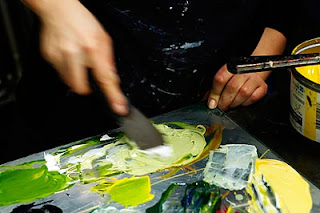 I bang on in my blog about learning the fundamentals of photography from using basic equipment and materials because I think it is the best way to learn. However, I know that for most people the film and Holga concept is a bit of fun that they will dabble with from time to time (if at all) so I thought it would be a good idea if I were to explain why I feel it is so important.
I bang on in my blog about learning the fundamentals of photography from using basic equipment and materials because I think it is the best way to learn. However, I know that for most people the film and Holga concept is a bit of fun that they will dabble with from time to time (if at all) so I thought it would be a good idea if I were to explain why I feel it is so important.I am not a commercial photographer but I do have one commercial client, my lovely wife Laura. Laura is an artist, specialising in lino and woodblock printing, though she also works in vitreous enamel (www.lauraboswell.co.uk). I designed and maintain her website and also produce all the photography that illustrates it, and any other marketing images that she needs. In some ways Laura is the dream client, she does not 'art direct' me and lets me do my own thing - though sometimes I get too arty and she asks for more straightforward pictures. In other ways she is a poor client, she never pays me, she hates every portrait I have ever taken of her and she does expect me to know what she has in mind to illustrate what she is doing...
 None of these four pictures is of Laura, they are of Rosa who works for Hand and Eye Press. Laura recently produced an edition of one of her prints with Hand and Eye, they are a fabulous Letterpress printer in London producing beautiful work. We both felt that this needed recording so I went along to photograph the work.
None of these four pictures is of Laura, they are of Rosa who works for Hand and Eye Press. Laura recently produced an edition of one of her prints with Hand and Eye, they are a fabulous Letterpress printer in London producing beautiful work. We both felt that this needed recording so I went along to photograph the work.These pictures were taken with an Epson RD-1, a camera I love, it has a 6 Mp sensor which produces files of a good quality, I wouldn't blow them up huge but I have yet to reach the limit. The nice thing about the RD-1 for me is that it handles very like a Leica, I had those in the past but sadly sold them. It does have automatic and I do use it but it is as near to a mechanical digital camera as you are likely to get... My own, self imposed, brief was to capture the setting, the machinery and the process in a dynamic way whilst still demonstrating just how 'hands on' the procedure is. If I had just set my camera to 'Program' I think it would have been very difficult to do this.
The first picture is of Rosa mixing ink to the correct colour, this will have been hand held at a 15th or possibly a 30th, slow enough to get a little movement in the hand and with enough depth of field to show the pallette. The next picture is of one of Laura's prints being dragged into the proofing press, guided by Rosa's finger. this will have been on a table-top tripod held against the wall probably at 1/2 or 1/4 of a second. Plenty of depth of field, enough sharpness in the hand whilst the print is almost fully blurred. Picture 3 is an almost abstract motion blur of Rosa turning the handle on the press. And the final picture shows what letterpress is really all about, moveable type, set and ready to print, deliberately photographed with the aperture wide open to get minimum depth of field, drawing attention to the type in the foreground.


None of this is difficult to do, it is all basic photographic technique but if you have not had a good grounding in the fundamental 'craft' of photography it is unlikely that you would stumble on any of these pictures accidentally. Knowing what it is that the controls on your camera do - not just that they put more or less light on the film or sensor, but just what a wider aperture will achieve or how well something can be illustrated with a carefully chosen amount of motion blur - these are the things that make photography such an immensely powerful illustrative medium.
 All of this can be learned from digital equipment, none of it is the exclusive domain of film, but I promote playing with film and 'toy cameras' because they force you to learn whilst most digital cameras allow you not to have to learn.
All of this can be learned from digital equipment, none of it is the exclusive domain of film, but I promote playing with film and 'toy cameras' because they force you to learn whilst most digital cameras allow you not to have to learn. So the crux is, what is better, living in a blissful but bland ignorance or learning through play?
I just hope my wife doesn't catch on about my playing with my toys in the office - and make me grow up!




No comments:
Post a Comment